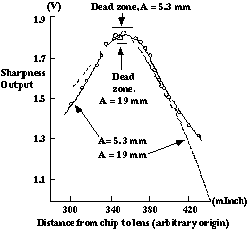Autofocus Chip & System
This page holds papers about a chips that have to do with autofocus.
The original paper (and the most interesting) is about a system I built that uses a silicon retina to measure image sharpness and includes an analog control system that dynamically tries to maximize the sharpness, using temporal derivatives of image sharpness and lens focus. This was my first independent project in Carver Mead's lab.
A later paper summarizes my first attempts to make practical devices, including a modernized image sharpness sensor.
The latest paper is about my most recent image sharpness sensor
- T. Delbrück. (2000). Silicon retina for autofocus, Invited session on Bio-inspired Microelectronics, ISCAS 2000, May 27–31, 2000, Geneva, Switzerland, pp. IV-393–396.
Summary of the first paper
The chip controls the lens dynamically to attain maximum sharpness of
the image falling on the chip. The idea is based on functioning of the human
focusing system. The human focusing mechanism is a one-dimensional control
system that self-generates necessary sensory input. Control systems of this
type are interesting, because we know that they are ubiquitous in the nervous
system, and because they form the basis of autonomous activity by an organism.
The human focusing system (technically part of the accomodation system)
oscillates around the point of best focus, as shown in these records: 
The power spectra of these oscillations show peaks at around 2Hz. The peakiness
of the power spectrum depends on the depth of focus. With a large aperture
lens (short focal length), the spectrum is more peaked: 
The primary hypothesis embodied in this chip is that control signals are
generated actively, by the motor system in the course of control. We have
built and characterized a model system that incorporates this hypothesis.
This circuitry, consisting of a specialized silicon retina that computes
image sharpness, and time-domain control circuits, dynamically and continually
focuses an image on the chip. The system looks like this: 
The circuits that compute the image sharpness look like this: 
The sharpness-computing circuit produces an response that looks like this: 
Tobi Delbruck
September 13, 2007




